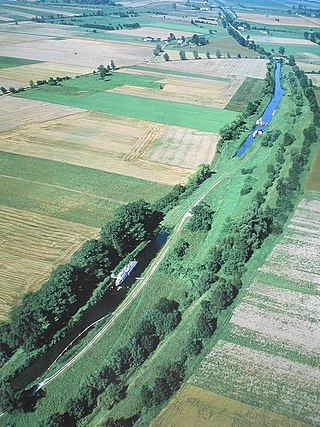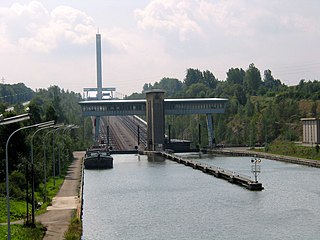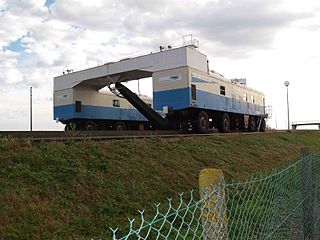
A water slope (French : Pente d'eau) is a type of canal inclined plane built to carry boats from a canal or river at one elevation up or down to a canal or river at another elevation.

A water slope (French : Pente d'eau) is a type of canal inclined plane built to carry boats from a canal or river at one elevation up or down to a canal or river at another elevation.
In 1885, German engineer Julius Greve published drafts for water slopes in German journals. French engineer Jean Aubert advanced the studies in the 1950s and 1960s. [1] [2]
To date, only two water slopes have been built, both in southern France. In 1973 the Montech water slope (French : Pente d'eau de Montech) was put into service on the Canal latéral à la Garonne .
In 1983 the Fonserannes Water Slope was inaugurated near Béziers on the Canal du Midi. Both water slopes run parallel to existing lock flights. Both water slopes are currently out of service and in disrepair. However, the slopes and their moving engines can be viewed from a distance.
The water slope uses a moveable gate in a sloping channel. To ascend the slope the moving gate can be opened to allow a boat to enter the concrete channel. The gate then closes off the bottom of the channel and seals off a wedge of water on which the boat is floating, within the channel. The moveable gate is drawn up the sloping concrete channel pushing the wedge of water before it until reaching the upper water level. When the water level in the wedge is equalised with that of the upper canal, an upper (non-moving) gate is opened and the boat is then allowed to float free. [3]
Descending the water slope is the reverse of the ascent.

A lock is a device used for raising and lowering boats, ships and other watercraft between stretches of water of different levels on river and canal waterways. The distinguishing feature of a lock is a fixed chamber in which the water level can be varied; whereas in a caisson lock, a boat lift, or on a canal inclined plane, it is the chamber itself that rises and falls.

An inclined plane is a type of cable railway used on some canals for raising boats between different water levels. Boats may be conveyed afloat, in caissons, or may be carried in cradles or slings.

A boat lift, ship lift, or lift lock is a machine for transporting boats between water at two different elevations, and is an alternative to the canal lock.

The Hay Inclined Plane is a canal inclined plane in the Ironbridge Gorge in Shropshire, with a height of 207 feet (63 m). It was located at the end of the Shropshire Canal, part of a network of canals that linked the industrial region of east Shropshire with the River Severn. The inclined plane was in operation from 1793 to 1894. It can be visited as part of the Blists Hill Victorian Town and is also a waypoint on the South Telford Heritage Trail.

Elbląg Canal is a canal in Poland, in Warmian-Masurian Voivodeship, 80.5 kilometres (50.0 mi) in length, which runs southward from Lake Drużno, to the river Drwęca and lake Jeziorak. It can accommodate small vessels up to 50 tonnes displacement. The difference in water levels approaches 100 metres (330 ft), and is overcome using locks and a system of inclined planes between lakes.

The caisson lock is a type of canal lock in which a narrowboat is floated into a sealed watertight box and raised or lowered between two different canal water levels. It was invented in the late 18th century as a solution to the problem posed by the excessive demand for water when conventional locks were used to raise and lower canal boats through large height differences. Such locks, each of which would only raise and lower boats through small height differences of a few feet, would not suffice when large height differences had to be tackled nor when water was in short supply. The caisson was thought to be one solution, although it transpired that the technology of the day was not capable of achieving this type of construction economically.
Dukart's Canal was built to provide transport for coal from the Drumglass Collieries to the Coalisland Canal in County Tyrone, Ulster, Ireland. It opened in 1777, and used three inclined planes, rather than locks, to cope with changes in level. There is little evidence that it was ever used, as the planes could not be made to work properly, and they were dismantled in 1787.

The Worsley Navigable Levels are an extensive series of coal mines in Worsley in the City of Salford in Greater Manchester, England. They were worked largely by the use of underground canals and boats called starvationers.

The Saint-Louis-Arzviller inclined plane is an inclined plane on the Marne-Rhine Canal that enables the canal to cross the Vosges Mountains. It is located in the commune of Saint-Louis, between the towns of Saint-Louis and Arzviller in the département of the Moselle.

The Ronquières Inclined Plane is a canal inclined plane on the Brussels-Charleroi Canal in the province of Hainaut in Wallonia, Belgium. It opened in April 1968 having taken six years to build. It is in the municipality of Braine-le-Comte and takes its name from the nearby village of Ronquières.

The Scharnebeck twin ship lift is a 38-metre (125 ft) boat lift in Scharnebeck, northeast of Lüneburg, in the District of Lüneburg, Lower Saxony, Germany. It is on the Elbe Lateral Canal, which connects the Elbe and the Mittellandkanal, and is one of two constructions on the canal that overcomes the height difference between the canal endpoints, the other being a 23-metre (75 ft) lock further south at Uelzen.

The Henrichenburg boat lift facilitates a change in elevation of the Dortmund-Ems-Kanal in Waltrop-Oberwiese. The boat lift is part of the Waltrop Lock Park (Schleusenpark), which includes the old Henrichenburg boat lift built in 1899, a disused shaft lock from 1912, the new boat lift built in 1962 and a modern ship lock from 1989.

The Niederfinow Boat Lift is the oldest working boat lift in Germany. It lies on the Oder-Havel Canal near Niederfinow in Brandenburg. The lift overcomes a difference in elevation of 36 metres.

The Montech water slope is a type of canal inclined plane built on the Canal de Garonne, in the commune of Montech, Tarn-et-Garonne, Southwest France. It is managed by the publicly owned Voies navigables de France and by-passes a series of five locks. The slope is used for larger vessels up to 40 metres in length, while smaller boats continue to use the locks.

The Rothensee boat lift is North of Magdeburg and connects the Mittellandkanal with the Elbe via the Elbeabstiegskanal.

A tub boat lift is a type of boat lift designed to lift tub boats between different elevations of a canal. Tub boats are small boats used to transport coal and other minerals, sometimes working singly, sometimes in long trains. A tub boat lift lifts the boat out of the water. Most other types of boat lift such as locks or inclined planes are designed to move the boat afloat in some kind of water-filled tank, and, apart from maximum dimensions, are not restricted in the type of craft transported. Tub boat lifts and tub boats are designed to work together as a system. A given lift will only be able to lift boats designed for the lift.

A tub boat was a type of unpowered cargo boat used on a number of the early English and German canals.

Jean Aubert was a French engineer. In 1961, he used the idea of the German engineer Julius Greve from the last century to describe a pente d'eau, which was a way of moving boats up the gradient of a canal without locks. The design consisted of a sloping channel, through which a wedge of water on which the boat was floating could be pushed up an incline. This concept was used in both the Montech water slope and the Fonserannes water slopes.

The Fonseranes Water Slope is a disused inclined plane on the Canal du Midi parallel to the Fonseranes Lock. It has a rise of 13.6 m (45 ft) and a slope of 5°.
43°19′49″N3°12′04″E / 43.33028°N 3.20111°E